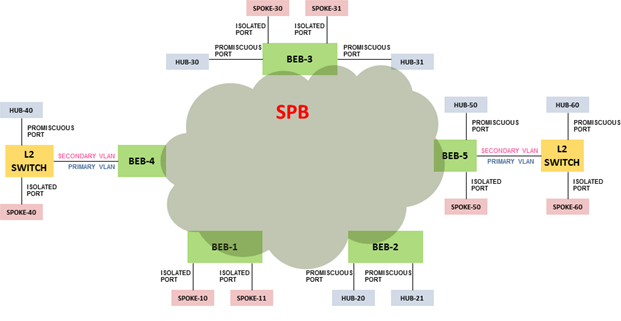E-Tree and Private VLAN topology
|
Feature |
Product |
Release introduced |
|---|---|---|
|
E-Tree and private VLANs |
5420 Series |
VOSS 8.4 |
|
5520 Series |
VOSS 8.2.5 |
|
|
VSP 4450 Series |
VSP 4000 4.0 |
|
|
VSP 4900 Series |
VOSS 8.1 |
|
|
VSP 7200 Series |
VOSS 4.2.1 |
|
|
VSP 7400 Series |
VOSS 8.0 |
|
|
VSP 8200 Series |
VOSS 4.1 |
|
|
VSP 8400 Series |
VOSS 4.2 |
|
|
VSP 8600 Series |
Not Supported |
|
|
XA1400 Series |
Not Supported |
|
|
Routing on Private VLANs |
5420 Series |
VOSS 8.5 |
|
5520 Series |
VOSS 8.5 |
|
|
VSP 4450 Series |
Not Supported |
|
|
VSP 4900 Series |
VOSS 8.5 |
|
|
VSP 7200 Series |
VOSS 8.5 |
|
|
VSP 7400 Series |
VOSS 8.5 |
|
|
VSP 8200 Series |
VOSS 8.5 |
|
|
VSP 8400 Series |
VOSS 8.5 |
|
|
VSP 8600 Series |
Not Supported |
|
|
XA1400 Series |
Not Supported |
Ethernet Private Tree (E-Tree) extends Shortest Path Bridging MAC (SPBM) to Private VLANs (PVLAN).
Transport within the SPBM network is achieved by associating the private VLAN with an I-SID. Flooded traffic from both promiscuous and isolated devices is transported over the same I-SID multicast tree and suppression for spoke-to-spoke traffic is done on the egress SPB Backbone Edge Bridge (BEB). This means the Private VLAN IDs are globally significant and must be the same on all BEBs
-
E-Tree associates a Private VLAN with an I-SID.

Note
The same I-SID could be attached to a regular VLAN. In that case, all ports on the regular VLAN behave like Promiscuous ports on the PVLAN.
-
Other SPB BEBs can associate a regular CVLAN to the same I-SID that E-Tree uses.

Note
The CVLAN ID must match the primary PVLAN ID.
-
CVLAN devices assigned to the same I-SID that E-Tree uses have Promiscuous connectivity within the segment.
The following figure shows a basic E-Tree network topology consisting of groups of private VLANs connected by the SPBM core network.

Private VLAN port types
The private VLAN port type is isolated, promiscuous, or trunk. If the port is a member of an MLT, then the port inherits the private VLAN type of the MLT.
In terms of network topology, the isolated port is considered a spoke. The isolated port, or spoke, does not communicate with any other isolated port in the network. The isolated port only communicates with the promiscuous ports, or hubs.
E-Tree and Private VLAN limitations
-
A port that is of Private VLAN type trunk must be tagged. Isolated and Promiscuous Private VLAN ports can be either tagged or untagged.
-
When a port or MLT that has a Private VLAN type set to Isolated or Promiscuous is added to a private VLAN, if that port is used by other non private VLANs, then those non private VLANs are removed.
-
A port which is Private VLAN type Isolated and is tagged can belong to only one Private VLAN.

